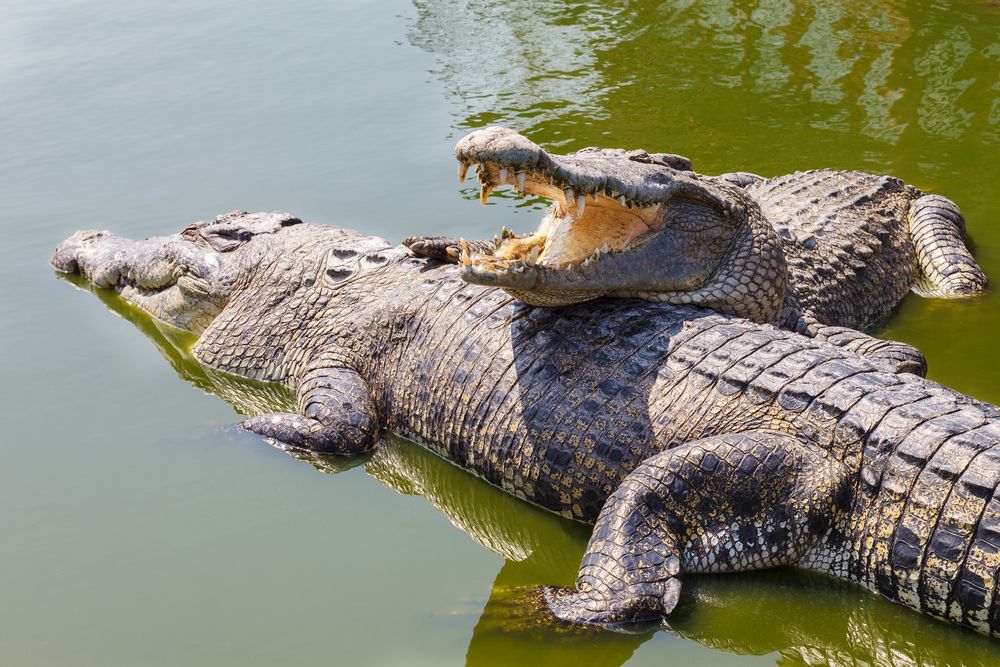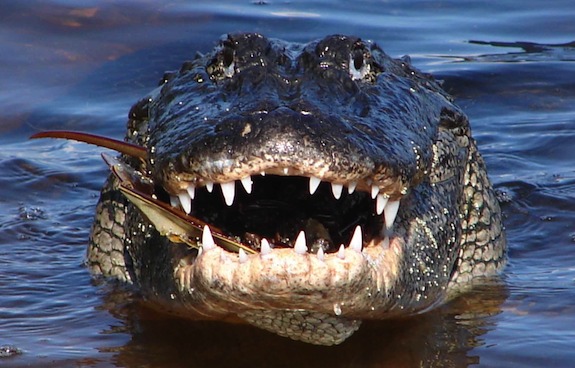It’s a question that has puzzled scientists, wildlife enthusiasts, and curious minds for centuries. These ancient reptiles, with their armored bodies and menacing jaws, are known for their prowess in the water.
In this article, we’ll explore the reasons behind Alligators and Crocodiles terrestrial travels, shedding light on their surprising behaviors and offering insights into their mysterious world beyond the water’s edge.
So, why do crocodiles and alligators go on land?
Can crocodiles live on land? It’s easy to assume that crocodiles and alligators are strictly aquatic creatures. Both species utilize land for basking in the sun to regulate their body temperature and for nesting and laying eggs. As formidable water predators, these reptiles can move surprisingly fast on land.
Going on land allows crocodiles and alligators to expand their territory beyond bodies of water. They can access different sources of food and explore new environments. This behavior helps them escape from potential threats in the water.

What Is An Alligator’s Natural Habitat?
Can alligators live on land? The natural habitat of alligators is primarily in freshwater environments, e.g., swamps, marshes, rivers, and lakes across the southeastern United States and parts of China. These reptiles are well adapted to their environment, with solid bodies, webbed feet, and powerful jaws.Alligators have a unique relationship with their environment.
Alligators share similarities with crocodiles, including their aquatic lifestyle and preference for warmer climates. Alligators tend to favor freshwater areas like rivers and swamps more than crocodiles, commonly found in freshwater and saltwater environments.
What Is A Crocodile’s Natural Habitat?
From the swamps and marshes of Florida to the rivers and lakes of sub-Saharan Africa and Australia, crocodiles are well-adapted to aquatic life. They thrive in tropical climates, inhabiting areas with warm water and ample prey like fish, birds, and small mammals.
One exciting aspect of crocodile habitats is their ability to tolerate fresh and saltwater environments. Alligators are mainly found in freshwater habitats like swamps and rivers; crocodiles can traverse between freshwater and saltwater ecosystems.
Why Do Alligators And Crocodiles Go On Land?
Alligators and Crocodiles venture onto land to regulate their body temperature. These cold-blooded reptiles require warmth to function efficiently, and by basking in the sun on riverbanks or swamps, they can raise their body temperatures to aid digestion and increase their activity levels. Crocodiles Alligators can manage their body temperatures effectively by moving between water and land.

To Lay Eggs
Alligators and crocodiles are well-known for their impressive water and land abilities. They come onto land for a particular reason – to lay eggs. Playing eggs on the ground allows crocodiles and Alligators to protect their offspring from aquatic predators.
The decision to lay eggs on land also enables crocodiles and alligators to regulate the temperature of their nests more effectively. By choosing specific spots on dry ground, these creatures can ensure their eggs receive the ideal heat for proper development.
To Bask In The Sun
Alligators and crocodiles often sunbathe on land, a leisurely activity with more profound significance. Ectothermic creatures rely on external heat sources to regulate their body temperature. Sunbathing allows them to warm up, increasing their metabolic rate for essential bodily functions like digestion and muscle movement.
This behavior serves a social purpose for these reptiles. Sun exposure also benefits skin health by regulating Vitamin D levels and killing harmful bacteria or parasites.
To Chase Prey
Many assume that crocodiles and alligators only go on land to chase prey. Hunting for food is a motivating factor; these reptiles also venture onto land for other essential activities. They lay their eggs in carefully selected nesting sites on dry ground, guarding them from predators until they hatch.

Alligators and crocodiles are formidable predators on land and in water; their terrestrial excursions serve multiple purposes beyond hunting. Their ability to thrive on solid ground and in aquatic environments highlights their remarkable adaptability and evolutionary success.
To Move Watering Locations
Crocodiles and Alligators, despite being expert swimmers, often venture onto land to move between watering locations. This behavior is not only a matter of convenience but also a strategic way for them to regulate their body temperature. By basking in the sun on the banks of rivers or lakes, these reptiles can absorb warmth and maintain their internal temperature at an optimum level.
Territorial behavior helps maintain social hierarchies within populations and ensures that individuals coexist without constant aggression over watering locations. The land-movement patterns of alligators and crocodiles reveal a fascinating blend of biological necessity and social dynamics that contribute to their survival in diverse ecosystems.
How Fast Are Crocodiles On Land?
How fast can an alligator run on dry land? Crocodiles are often associated with their stealth and speed in water, but their land speed is equally remarkable. Crocodiles can reach impressive speeds on the ground when motivated to do so. Researchers have found that on land, crocodiles can achieve a sprinting speed of up to 11 miles per hour (17 kilometers per hour).
This behavior showcases a unique adaptation that allows these reptilian giants to thrive in diverse environments. The combination of muscular strength, long limbs, and an efficient gait enables them to move swiftly across the terrain.

How Fast Are Alligators On Land?
.Alligators may seem sluggish in the water, but don’t be fooled–these reptiles are surprisingly swift on land. With their heavy bodies and short legs, alligators can reach speeds up to 11 mph for short bursts. This surprises many people who often assume that alligators are slow and clumsy out of water.

The secret to their surprising speed lies in their musculature and body design. Alligators can quickly propel themselves forward with powerful leg muscles and a streamlined body shape. They can move with impressive agility on terra firma as well.
Conclusion
The behavior of alligators and crocodiles on land serves several essential purposes, including thermoregulation, nesting, and protecting their territory. This adaptation allows them to efficiently regulate their body temperature, build nests in suitable locations, and defend their territory against intruders. These behaviors are crucial for conservation efforts and habitat protection, as they shed light on the ecological needs of these species. As we continue to study and appreciate the unique behaviors of crocodiles, it becomes increasingly important to ensure the preservation of their natural habitats.